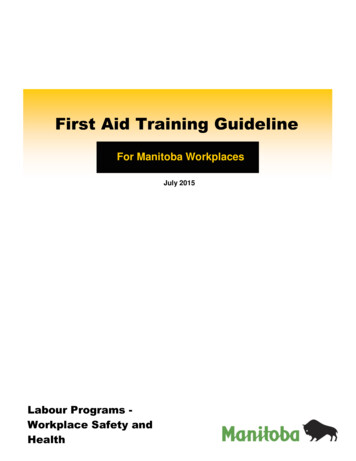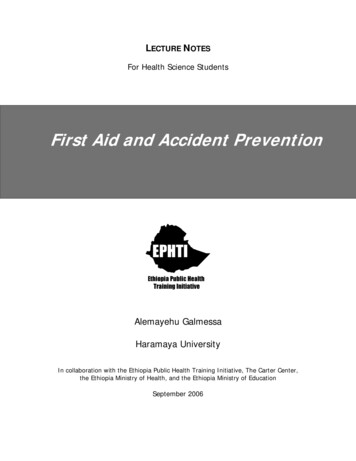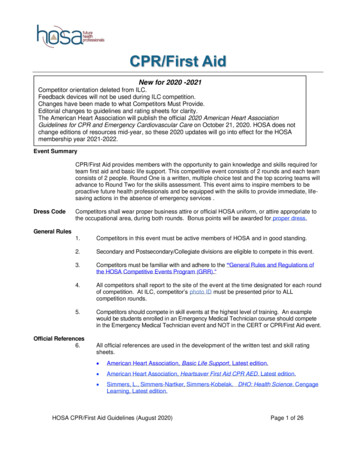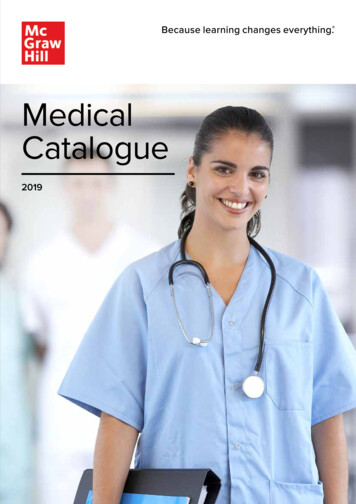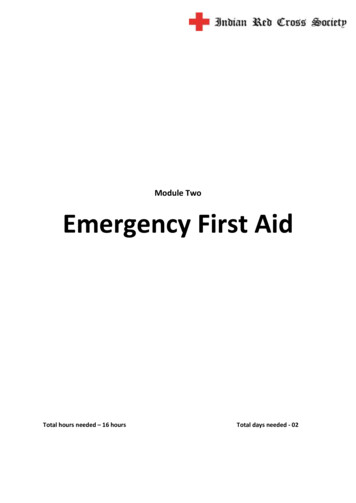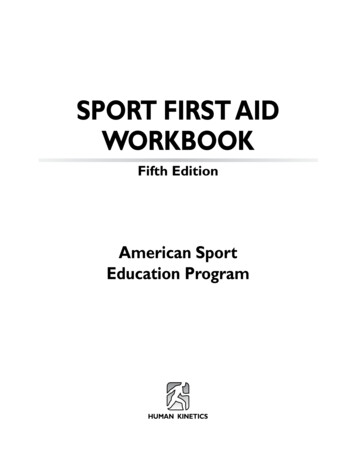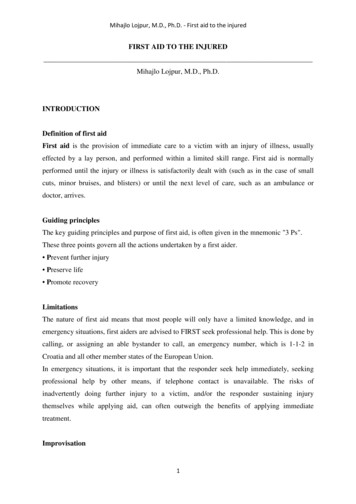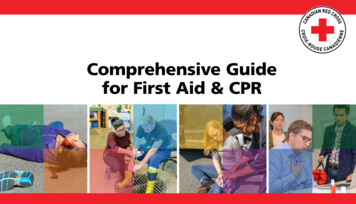
Transcription
Comprehensive Guidefor First Aid & CPR
Table of ContentsThe Fundamental Principles of the InternationalRed Cross And Red Crescent Movement0101 the red cross02Our History.The Fundamental Principles.Red Cross Emblems.Who We Are.How We Help.02 responding to emergencies030304050507Preparing to Respond.08Preparing for Emergencies at Home.Recognizing that an Emergency Exists.Willingness to Act.091111Legal Issues Around First Aid.12Good Samaritan Laws.Workplace First Aiders.Getting Permission to Help.Duty to Report Child Abuse or Neglect.Responding to Disclosures of Violence.1212121313The Emergency Medical Services System.14Chain of Survival Behaviours.Understanding Your Role as a First Aider.Understanding Your Role in the EMS System.Activating EMS.When to Call EMS/9-1-1.Poison Control Centres.Calling EMS/9-1-1 for a Child in Your Care.14141515161617After an Emergency.Lowering the Risk of Infection.1718How to Prevent Diseases from Spreading.Personal Precautions.Equipment Precautions.Environmental Precautions.1919202203 check, call, careCheck.Call.Care.Secondary Assessment.Shock.Providing First Aid for Someone with a Disability04 choking2425283033363740Partial Choking.Complete Choking.4344Responsive Adult or Child over 12 Months.If You Are By Yourself and Choking.4444Responsive Baby (Less Than 12 Months).47Unresponsive Choking.4805 circulation emergencies49Cardiovascular Disease.Heart Attack.Angina.Stroke.Transient Ischemic Attack (TIA).Life-Threatening Bleeding.505153535555Life-Threatening External Bleeding.Using a Tourniquet.Using Hemostatic Dressings.Life-Threatening Internal Bleeding.5557585806 cpr & aed59Cardiac Arrest.60Cardiac Arrest, Adult (After the Onset of Puberty).Cardiac Arrest, Child (1 Year to the Onset of Puberty)Cardiac Arrest, Baby (Less Than 12 Months).Continue CPR Until .What to Do if the Rescue Breaths Don’t Go In.Compression-Only CPR.CPR Compression Depth.Chest Compression Rates.Chest Recoil.Decreasing Compression Fraction (Off-Chest Time).Special Considerations.CPR for a Pregnant Woman.Air in the Stomach.Vomiting.Mouth-to-Nose Breathing.Mouth-to-Stoma d External Defibrillation.69Using an AED.Medical Direction and AEDs.AED Maintenance.707374Working as a Team.7407 breathing emergencies75Respiratory Distress.Hyperventilation.Asthma.767778Using an Inhaler.Using an Inhaler with a Spacer.8080Allergic Reactions.Anaphylaxis.8082
Table of Contents08 wound care85Bandaging Guidelines.Triangular Bandages.Cuts and Scrapes.Puncture Wounds.Scalp Injuries.Infection.Burns.86868788888990Thermal Burns.Chemical Burns.Electrical Burns.Radiation Burns.Special Considerations When Caring for Burns.11 sudden medical emergencies120124125126127Using a Glucagon Kit.12991939394Seizures.129Febrile Seizures.132Mental Health Crisis.132Self-Inflicted 79798100101102103103Penetrating Chest Injuries.Blunt Chest Injuries.104105Abdominal Wounds.Blast Injuries.The Neck and Spine.The Brain.Concussion.Shaken Baby Syndrome.Splinting Guidelines.Osteoporosis.117Fainting.Diabetic Emergencies.Bruises.Splinters.Nosebleeds.Foreign Objects in the Nose.Knocked-Out Teeth.Eye Injuries.Ear Injuries.Impaled Objects.Amputations.Crush Injuries.Chest Injuries.09 head, neck, and spinal injuries10 bone, muscle, and joint injuries12 environmental illness136How Body Temperature is Controlled.Heat-Related Illnesses.137139Heat Cramps.Heat Exhaustion.Heat Stroke.140140143Cold-Related Illnesses.144105106Frostbite.Hypothermia.Freezing of Skin to Metal Objects.Snow Blindness.Cold-Water Immersion.144146149149150Drowning.151107Responsive Drowning Person.Unresponsive Drowning Person.152108109112115Seasickness.15215113 poisonsIdentifying Hazardous Materials.Swallowed Poisons.Inhaled Poisons.153155157158Carbon Monoxide Poisoning.158Absorbed Poisons.159Poison Ivy, Sumac, and Oak.Giant Hogweed and Wild Parsnip.160161Injected Poisons.Poisoning Caused by Alcohol or Drugs.162163Drug Overdose.Opioid Overdose.Alcohol Poisoning.163164164Bites and Stings.165Animal Bites.Rabies.Insect Stings.Tick Bites.Lyme Disease.Snakebites.Spider Bites.Black Widow Spiders.Brown Recluse Spiders.Stings from Marine Life.165166166167168169171171171172
Table of Contents14 childhood illnesses174Protecting Children from Infection and DiseaseQuestions to Ask Yourself if You Thinka Child May Be Ill.When to Call the Parent of a Child in Your CareCommon Childhood Conditions:Guidelines for Care.175Safe Use of Wheeled Equipment.195175177Choosing a Safe Bicycle.Choosing a Safe Helmet.Safe Use of Bicycles.Safe Use of Skateboards and Rollerblades.195195195196177Fire Safety.196Comparison Chart for Epiglottitis and Croup.186Childhood Fevers.187Taking a Child’s Temperature.Complications Related to Fever.187188Reducing the Risk of Fire and Burns.Fire Escape Plan.What to Do in the Case of Fire During the Night.196197197Giving Medications.188Ice Safety.Water Safety.197197When to Give Medications.General Rules for Medication.Medication in the Eye.Medication in the Nose.188189189189General Tips for the Prevention of Drowning.Safe Use of Bathtubs.Safe Use of Backyard Pools and Hot Tubs.Safe Swimming.Safe Boating.197198198198199Teaching Children Safety Awareness.Child and Youth Protection.199199Abuse and Violence.Neglect.Understanding Bullying and Harassment.Responding to Disclosures.199200200200Childrens’ Hygiene.201Diapering.Dental Health.20120115 caring for children190Toy and Equipment Safety.191Equipment for Babies.Safe Use of Cribs.Safe Use of Playpens.Safe Use of High Chairs.Safe Use of Baby Strollers.Safe Use of Pacifiers.191191191191192192Equipment for Children.192Safe Use of Child Bike Trailers.Safe Use of Safety Gates.192192Toys for Children and Babies.Playground Safety.Car Safety.193193194Safe Use of Car Seats.Passenger Rules for Children: Safety Education.194194appendix a – kit contents202Example of an Emergency Supplies Kit. 202Example of an Emergency Car Kit. 202appendix b –moving an ill or injured personBody Mechanics.How to Move an Ill or Injured Person.Stretchers and Lifting Devices.appendix c – anatomy and physiology203204204207210Body Systems.Interrelationships of Body Systems.210210Respiratory System.Circulatory System.Nervous System.Musculoskeletal System.Muscles.Skeleton.Integumentary System.Digestive System.Urinary System.Reproductive knowledgements227
The Fundamental Principles of the InternationalRed Cross and Red Crescent MovementHumanityVoluntary ServiceThe International Red Cross and Red Crescent Movement, born of adesire to bring assistance without discrimination to the wounded onthe battlefield, endeavours in its international and national capacity toprevent and alleviate human suffering wherever it may be found. Itspurpose is to protect life and health and ensure respect for the humanbeing. It promotes mutual understanding, friendship, co-operation, andlasting peace amongst all peoples.It is a voluntary relief movement not prompted in any manner bydesire for gain.ImpartialityIt makes no discrimination as to nationality, race, religious beliefs, class,or political opinions. It endeavours to relieve the suffering of individuals,being guided solely by their needs, and to give priority to the mosturgent cases of distress.NeutralityIn order to continue to enjoy the confidence of all, the Movement maynot take sides in hostilities or engage at any time in controversies of apolitical, racial, religious, or ideological nature.IndependenceThe Movement is independent. The National Societies, while auxiliaries inthe humanitarian services of their governments and subject to the laws oftheir respective countries, must always maintain their autonomy so thatthey may be able at all times to act in accordance with the principles ofthe Movement.UnityThere can be only one Red Cross or one Red Crescent Societyin any one country. It must be open to all. It must carry on itshumanitarian work throughout its territory.UniversalityThe International Red Cross and Red Crescent Movement,in which all Societies have equal status and share equalresponsibilities and duties in helping each other, is worldwide.The Fundamental Principles were proclaimed by the XXthInternational Conference of the Red Cross, Vienna, 1965. This isthe revised text contained in the Statutes of the International RedCross and the Red Crescent Movement, adopted by the XXVthInternational Conference of the Red Cross, Geneva, 1986.In keeping with the Fundamental Principles of the Red Cross, theSociety is committed to Social Justice in the elimination of Societystructures and actions that oppress, exclude, limit, or discriminateon the basis of race, gender, ethnicity, financial ability, sexualorientation, religion, disability, or age.
1 The Red Cross
Our HistoryIn June of 1859, Henry Dunant saw anunforgettable scene: 40,000 dead andwounded soldiers left on the field after theBattle of Solferino in Italy. Dunant organizedlocal villagers into first aid teams to help asmany of the wounded as possible, savingthousands of lives.The Red CrossTo prevent this horror from happeningagain, Dunant decided to create a neutralorganization to care for wounded soldiersand prisoners—an organization that wouldbe respected and protected by both sidesin any conflict. The result was the Red Cross.Dunant spent the rest of his life trying toreduce the suffering caused by war. He lobbiedgovernments, organized Red Cross Societies indifferent countries, and spoke to the public.3In the spring of 1885, during Louis Riel’sNorthwest Rebellion, Dr. George SterlingRyerson stitched a red cross made of cottononto white material and used this as a flag todistinguish the horse drawn wagon being usedto transport the wounded. This was one of thefirst Red Cross flags ever flown in Canada. In1896, Dr. Ryerson founded the first overseasbranch of the British Red Cross, which laterbecame the Canadian Red Cross.In 1901, Dunant won the first Nobel Peace Prize.By founding what is now the InternationalRed Cross and Red Crescent Movement, he hassaved the lives of millions of people.On May 19, 1909, The Canadian Red Cross Society Act was approved byParliament, and decreed that the Canadian Red Cross would serve asan auxiliary to the Government of Canada for Canadians, which was ameasure that was in accordance with the Geneva Conventions. (Prior to1909, the Canadian Red Cross operated as a branch of the British RedCross.) As a result, for more than a century, Canadians have had theirown national Red Cross Society dedicated to improving the situations ofthe most vulnerable people in Canada and around the world.Today, there are Red Cross or Red Crescent Societies in more than 190countries, all dedicated to the same ideals and fundamental principles.The Fundamental PrinciplesIn every country, our programs and activities are guided by sevenFundamental Principles. The Tanzanian Red Cross has created a short,simple version of these principles:Humanity: We serve people, but not systems.Impartiality: We care for the victims and the aggressors alike.Neutrality: We take initiatives, but never take sides.Independence: We bow to needs, but not rulers.Voluntary Service: We work around the clock, but never for personal gain.Unity: We have many talents, but a single idea.Universality: We respect nations, but our work knows no boundsEssentially, we provide help to people in need, whatever their race,gender, culture, ethnicity, financial ability, sexual orientation, religion,disability, or age.
Red Cross EmblemsThe Red CrescentThe International Red Cross and Red Crescent Movement has threeofficial symbols: The red cross, the red crescent, and the red crystal.All three symbols are equivalent and share the same status underinternational law. Each national society of the International Red Crossand Red Crescent Movement chooses one of these three symbols to usein their country.Although the red cross emblem has no religious,political, or cultural associations, it was sometimesbelieved to be related to the Christian cross, and thisassociation was problematic in certain regions andconflicts. In 1929, the International Federation of theRed Cross agreed to the adoption of an additional,equivalent emblem: The red crescent. This emblemcould be used by any national society in place of thered cross.The three emblems are used to identify military medical services as wellas the people, programs, and objects connected with the activities of theInternational Red Cross and Red Crescent Movement.Recognized as a symbol of humanity and neutrality, the emblem is theonly protection Red Cross workers have when they bring relief andprotection to victims of armed conflicts. The emblem identifies andprotects the sick, the wounded, and those who come to their aid; medicalequipment; buildings; and vehicles.The Red CrossThe Red Cross4The red cross—five red, equal-sized squares forminga cross resting on a white background— was adoptedin 1863 at the first International Conference of whatwould one day be the Red Cross and Red CrescentSociety. Today it is one of the most recognizedemblems in the world, and continues to be an internationally respectedsymbol of protection and neutrality.The red cross is the emblem that is used by the Canadian NationalSociety. No organization—except the Canadian Red Cross and themedical services of the armed forces—has the right to use the red crossemblem in Canada. The red cross emblem must be readily recognizedand respected around the world as a trusted symbol of protection andhumanitarian aid. Its use is legislated by the Geneva Conventions Act, theTrade Marks Act, and the Canadian Red Cross Society Act.The Red CrystalIn December of 2005, the International Red Cross andRed Crescent Movement welcomed the decision tocreate an additional emblem alongside the red crossand red crescent: the red crystal.
Who We AreOur MissionThe mission of the Canadian Red Cross is to improve the lives ofvulnerable people by mobilizing the power of humanity in Canada andaround the world.Our VisionThe Canadian Red Cross is the leading humanitarian organizationthrough which people voluntarily demonstrate their caring for others inneed.Our ValuesOur actions and decisions are based on: Humanitarian values, as expressed in our Fundamental Principles; Respect, dignity, and care for one another within and outsidethe Canadian Red Cross; and Integrity, accountability, effectiveness, and transparency.How We HelpThe Canadian Red Cross provides help in many ways:Disaster ManagementWhile many associate the CanadianRed Cross with its disaster relief effortsaround the world, each year thousandsof Canadians receive aid followingemergencies such as house fires,flooding, ice storms, and even chemicalspills. Following a disaster, Canadian Red Cross volunteers ensure thoseaffected have access to shelter, food, clothing, hygiene items, andemotional support. As part of a global network of 190 national Societies,the work and expertise of the Canadian Red Cross often extends beyondCanada’s borders. Trained Canadian personnel and resources, includingan Emergency Response Unit specializing in health, are poised fordeployment within hours of a disaster.International OperationsThe Red CrossOur Volunteers5The Canadian Red Cross relies on more than 25,000 volunteers acrossthe country to fulfill its mission. Red Cross volunteer opportunities aredynamic and varied, with engagement levels varying by geographiclocation and program. For more information on volunteering, visitredcross.ca or contact your local Red Cross office.The Canadian Red Cross works aroundthe world to protect and promote therights of all people affected by armedconflict. The Geneva Conventions, lawsthat protect the wounded, the sick,prisoners of war, and civilians, serve asa mandate for the Canadian Red Crossin its mission to provide assistance to those in need. The Canadian RedCross educates Canadians on international issues including humanitarianlaw and development efforts. The Society recruits and trains qualifiedCanadian delegates for international field operations in countriesaffected by conflict or disaster or for long-term development missions.
First Aid ProgramsAs the largest provider of first aidtraining in Canada, the Canadian RedCross has been offering first aid andCPR training for more than 50 years.With courses for individuals, groups,workplaces, and first responders,participants learn how to preventinjuries and to think, react, and respondin emergency situations.Swimming and WaterSafety ProgramThe Red CrossSince 1946, the Canadian Red Cross hasbeen teaching Canadians how to staysafe around the water through ourSwimming and Water Safety programs.Water safety activities are offered atcommunity pools, beaches, schools andsummer camps to help people of allages and abilities gain knowledge andskills in every aspect of water safety.6Respect EducationThe Canadian Red Cross aims toprevent abuse, neglect, harassment,and interpersonal violence toensure everyone’s right to live, play,and learn in a safe environment.Nationally recognized, award-winningprograms teach children, youth, andadults about healthy relationships,the signs of abuse, dating violence, personal safety, bullying prevention,and how to get help. Prevention educators with extensive training inabuse prevention deliver workshops to school and community groups,sports teams, coaches, educators, and parents or guardians. The aim is tostop the hurt before it starts.Community Health and WellnessCanadian Red Cross staff and volunteerswork together to provide a varietyof services that help people remainliving independently in their homeswith comfort and dignity, despiteinjury, illness, or other circumstances.Nutrition-based programs, such asMeals on Wheels, provide nutritionally balanced meals and eliminatethe guesswork for clients and caregivers in meeting daily dietaryrequirements; transportation services ensure people in the communityget to and from medical appointments, grocery shopping, and more;and health equipment loans provide short-term loans of clean, safemedical equipment to people who are recovering from injury, illness, orsurgery. Our programs are designed to enhance quality of life, supportindependence, and provide peace of mind. The services offered in eacharea vary according to the needs of the community.
2 Responding to Emergencies
Preparing to RespondFirst aid kits should as a minimum include the following supplies:Responding to EmergenciesMake sure you have easy access to items that will help you respond toan emergency. Keep a first aid kit in your home and vehicle, and ensurethat you know the location of the first aid kit and automated externaldefibrillator (AED) in your workplace. Download the Canadian Red CrossFirst Aid App to your mobile device so that you always have a first aidreference readily available.8You can purchase first aid kits andsupplies from the Canadian Red Crossonline store (products.redcross.ca), adrug store, or a medical supplies store.Whether you buy a first aid kit orassemble one yourself, make sure it hasall of the items you may need. Performregular maintenance and safety checkson all first aid kits and equipment.Remove or replace any items thatare broken, expired, discoloured, orcontaminated (e.g., a sterile toolin a torn package). You should alsodecontaminate any reusable equipmentthat has been used (e.g., a stretcher).All workplace first aid kits must meet provincial/territoriallegislation and occupational health and safety guidelines.Go to redcross.ca/firstaidlegislation for more details. Emergency telephonenumbers for EMS/9-1-1,your local Poison ControlCentre, and your personaldoctor(s) Home and office phonenumbers for familymembers, friends, orneighbours who can help inan emergency Sterile gauze pads(dressings) in small andlarge squares to place overw
1909, the Canadian Red Cross operated as a branch of the British Red Cross.) As a result, for more than a century, Canadians have had their own national Red Cross Society dedicated to improving the situations of the most vulnerable people in Canada and around the world. Today, there are Red Cross or
